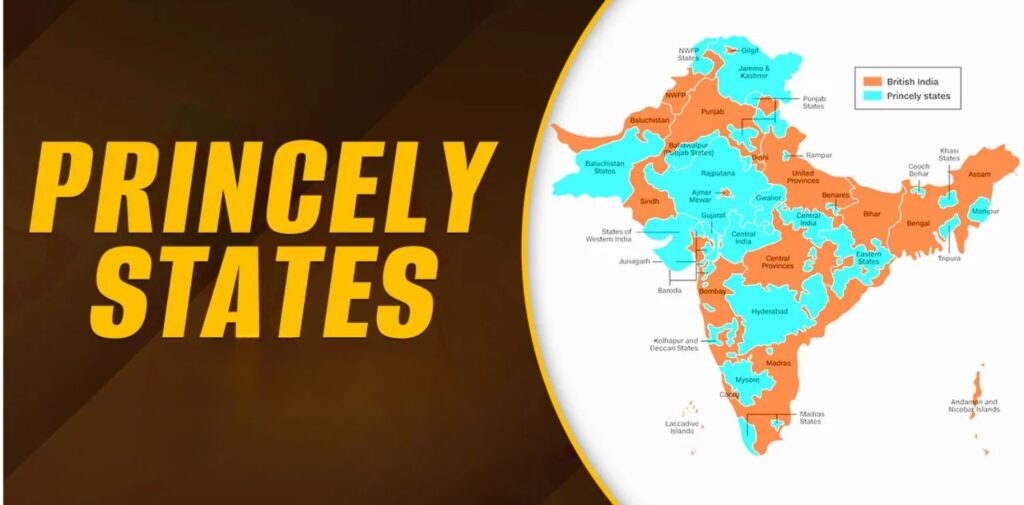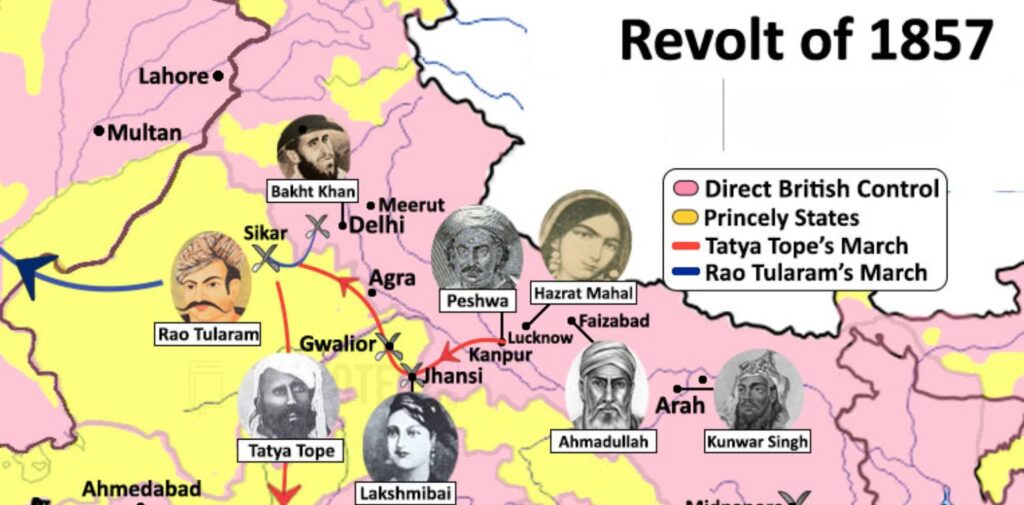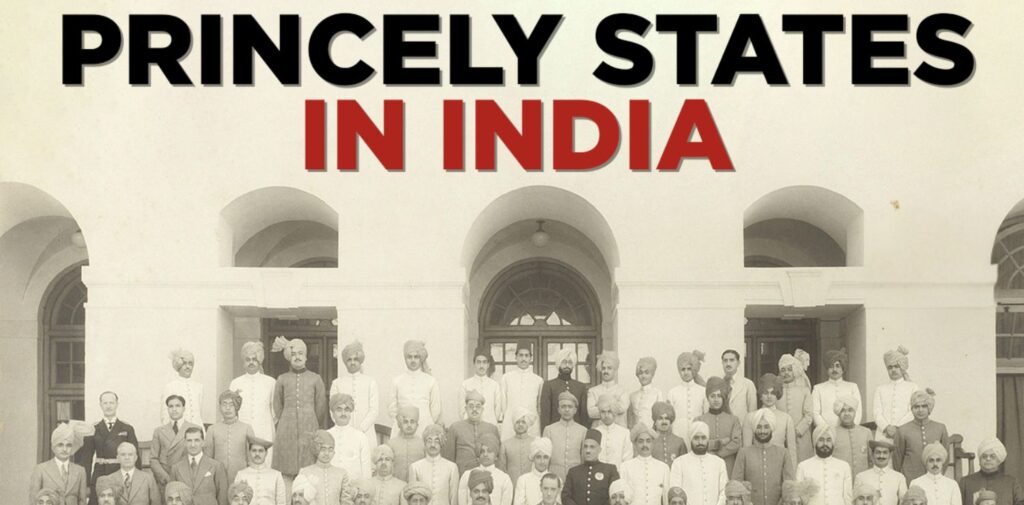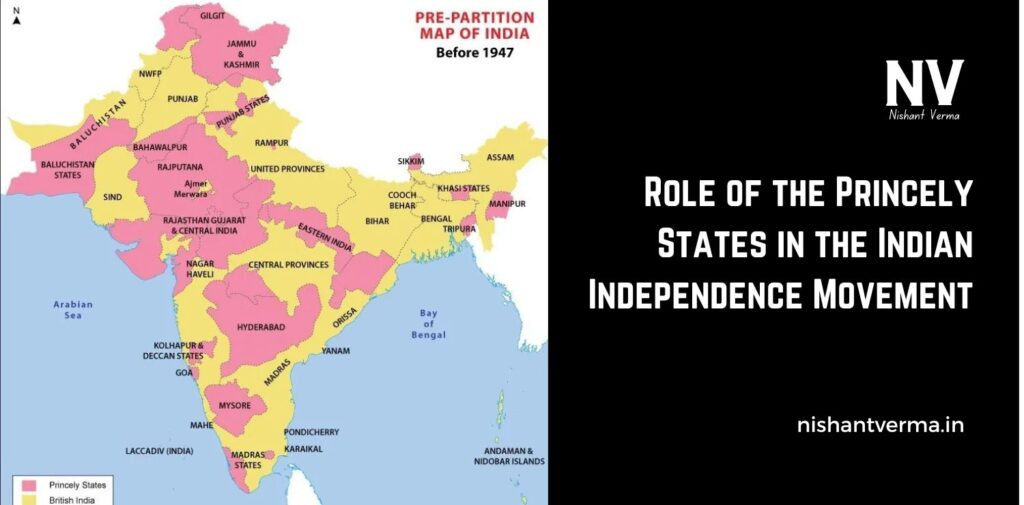India’s path to independence in 1947 was a long and difficult journey. It wasn’t just about the British rulers and the people fighting for freedom. There was another important group of people in the struggle: the Princely States. These were regions in India that were ruled by kings, maharajas, or nawabs. They were not directly controlled by the British government, but instead, they had a special agreement with the British through a system called subsidiary alliances. The Princely States played a very interesting and complex role in India’s freedom movement. Let’s understand their importance in simple terms.
What Were the Princely States?
Before we dive into the role of the Princely States in the Indian Independence Movement, we need to understand what they were. India, before independence, was divided into two main regions:
- British India – areas directly ruled by the British government.
- Princely States – regions ruled by Indian kings, maharajas, or nawabs, but still under British influence.
There were about 565 Princely States spread across India. These states were not part of British India, but the British had agreements with the rulers, which meant that the rulers were required to accept British control over matters like defense and foreign affairs. However, the kings and maharajas still had control over local matters in their states.

How Did the Princely States Affect India’s Politics?
While India was under British control, it wasn’t just about the British rulers and the people who wanted independence. The Princely States were an important part of the picture. These states were often seen as part of the power structure in India, and they had a complex relationship with the British. Some rulers were friendly with the British, while others resisted their control.
The British government used the Princely States to maintain their power over India. The system of subsidiary alliances, introduced by the British officer Lord Wellesley in the 18th century, was a key part of this. Under this system, Indian rulers were forced to have British troops in their states and support British policies. They were also required not to enter into agreements with other foreign powers without the British approval.
Despite this, many of the rulers in the Princely States enjoyed considerable power and freedom. Some were sympathetic to the idea of Indian independence, while others were more concerned about keeping their own positions of power.
The Princely States and the Indian National Congress
The Indian National Congress (INC), which was formed in 1885, became the main political party leading the struggle for India’s independence. The INC wanted to bring all parts of India together in the fight for freedom, including the Princely States. However, the rulers of the Princely States were often hesitant to join the movement.
Many of the Princely States remained neutral, while some even supported the British. However, there were a few rulers who were sympathetic to the cause of Indian independence. They believed that the British should leave India and that their people should have more control over their own destinies.
One of the most famous leaders who played a significant role in the independence movement from the Princely States was Maharaja of Travancore, Sree Chithira Thirunal Balarama Varma. He took progressive steps, such as allowing the Indian National Congress to hold a conference in his state. This act of support from a ruler of a Princely State was a significant moment in India’s freedom struggle.

The Princely States During the Revolt of 1857
One of the most important events in India’s freedom movement was the Indian Rebellion of 1857 (also known as the First War of Independence). This was a large-scale uprising against British rule, and it involved both Indian soldiers and civilians. Some of the Princely States played a significant role in this rebellion.
For example, the Nawab of Oudh (also known as the Nawab of Lucknow), Begum Hazrat Mahal, fought bravely against the British forces. She was a strong leader who led the rebels and tried to protect her kingdom from British forces. Similarly, Rani Lakshmibai of Jhansi was another famous ruler who fought against the British during the 1857 revolt. She is remembered as a symbol of courage and resistance.
However, many of the Princely States did not join the revolt and either remained neutral or sided with the British. This made the uprising a difficult one, as the British were able to use the loyalty of some Indian rulers to crush the rebellion.
The Role of the Princely States After 1930s
In the 1930s, as the Indian National Congress gained more popularity and power, there was growing pressure on the Princely States to take a stand on the independence movement. The leaders of the INC, including Mahatma Gandhi, urged the rulers of the Princely States to support the freedom struggle.
Some Princely States, like Hyderabad, Mysore, and Travancore, started to show some interest in the ideas of Indian independence. They began to focus more on local governance and even tried to introduce reforms in their states to improve the conditions of their people. However, not all rulers were open to this change.
At the same time, the Quit India Movement in 1942, led by Gandhi, put pressure on everyone, including the Princely States. The British were becoming weaker, and more people, including those in the Princely States, started to demand independence.

The Accession of the Princely States to India
The most significant event that shaped the role of the Princely States in the independence movement happened after India gained independence in 1947. At the time of independence, India was divided into two countries: India and Pakistan. However, the Princely States were still free to decide whether they wanted to join India or Pakistan.
Sardar Vallabhbhai Patel, who was one of India’s key leaders, played a major role in persuading the rulers of the Princely States to join the Indian Union. Some rulers agreed to join India, while others hesitated or resisted. For example, the Nizam of Hyderabad initially refused to join India, leading to the Police Action (also known as the Hyderabad Conflict) in 1948, where India took control of the region.
In some cases, the rulers of the Princely States agreed to merge with India willingly, while in others, the process was more difficult. The rulers who accepted the idea of independence for all Indians helped in the creation of a united nation. In the end, almost all the Princely States merged with India.
Conclusion
The Princely States played a mixed role in India’s struggle for independence. While many of the rulers were not directly involved in the freedom movement, some supported it in their own way. The attitude of the rulers varied: some were loyal to the British, while others were sympathetic to the Indian National Congress and its goals.
The most important impact of the Princely States was seen after India gained independence, when they had to decide whether to join India or Pakistan. The integration of these states into India helped create a united country and ended the division created by British rule.
The Princely States, despite their varying roles, were an important part of India’s journey to independence, and their decision to join the Indian Union shaped the country as we know it today.




